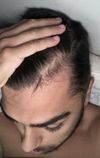community Still getting DHT itch after 6 months on Finasteride, should I swap to Dutasteride?
User is experiencing scalp itch and hair loss despite using Nizoral, Minoxidil, derma rolling, and Finasteride for 6 months. They are considering switching to Dutasteride.
